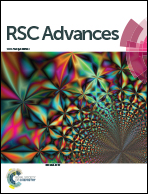Emulsion click microspheres: morphology/shape control by surface cross-linking and a porogen
Abstract
Click chemistry plays a dual role in emulsion microsphere (MS) preparation as both an in situ cross-linking method and a bioconjugation route. The morphology/shape of the MSs can be adjusted by applying surface click cross-linking and a porogen simultaneously. The emulsion click cross-linked MSs have potential application in drug delivery, and the preserved azide groups could be used for further surface conjugation with bioactive molecules.


 Please wait while we load your content...
Please wait while we load your content...